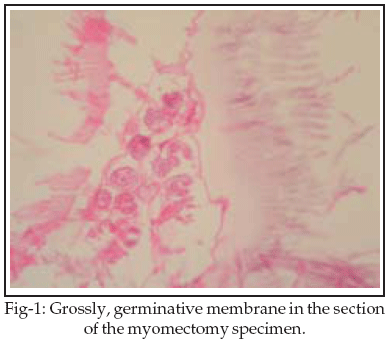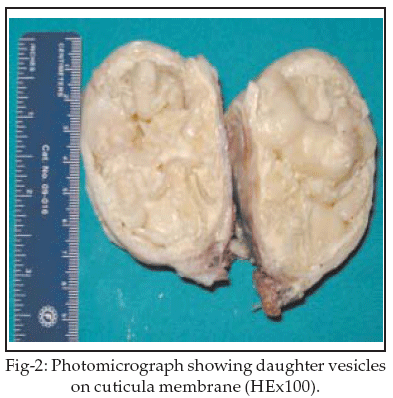|
|
||||
|
Published by : PROFESSIONAL MEDICAL PUBLICATIONS |
||||
|
ISSN 1681-715X |
||||
|
||||
|
- |
||||
|
CASE REPORT |
||||
|
- |
||||
|
Volume 23 |
October - December 2007 (Part-I) |
Number 5 |
||
|
|
||||
|
|
||||
|
|
||||
|
Published by : PROFESSIONAL MEDICAL PUBLICATIONS |
||||
|
ISSN 1681-715X |
||||
|
||||
|
- |
||||
|
CASE REPORT |
||||
|
- |
||||
|
Volume 23 |
October - December 2007 (Part-I) |
Number 5 |
||
|
|
||||
|
|
||||
A hydatid cyst found in an uncommon
site coincidentally
Nihal Kilinc1, Cigdem Arican2
ABSTRACT
Echinococcosis or hydatid cyst disease is a common parasitic disease that is known to affects both humans and animals. Echinococcosis manifests as a cyst formation, is caused by E. Granulosis (unilocular cystic) and E. Alveolaris (multilocular cystic) and is an important health problem in poorly developed countries. In this paper, we report and discuss a rare case of primary hydatid disease presenting as uterus leiomyoma at 33-weeks of gestation. Hydatid cysts in the genital tract are rare and gynaecologists should be cognisant of the possibility of hydatid cysts when a mass is found in the uterus.
KEY WORDS: Hydatid cyst, Echinococcus, Uterus, Leiomyoma, Pregnancy.
Pak J Med Sci October - December 2007 (Part-I) Vol. 23 No. 5 774-776
1. Dr. Nihal Kilinc, MD
Associate Professor,
2. Dr. CigdemArican, MD
Assistant Director,
1-2: Dicle University, Medical Faculty,
Department of Pathology,
Diyarbakir – Turkey.
Correspondence
Dr. Nihal Kilinc, MD,
Department of Pathology,
Faculty of Medicine,
Dicle University,
21280 Diyarbakir – Turkey.
E-mail: nhl@dicle.edu.tr
* Received for Publication: April 16, 2007
* Revision Received: July 20, 2007
* Revision Accepted: July 26, 2007
INTRODUCTION
Hydatid disease (hydatidosis) is a common zoonosis that affects a large number of humans and animals, especially in poorly developed countries.
1 A parasitic tapeworm, called Taneia Echinococcus, causes hydatid disease. The infecting parasite has four forms: Echinococcus granulosis (unilocular cystic), E. Alveolaris (multilocular cystic), E. vogeli and E. oligarthrus (very rare in humans).1,2 Hydatid disease is at its highest prevalence in major sheep and cattle-raising areas of the world.3 The ova, which are resistant to many environmental conditions, are excreted in the feces and ingested by the intermediate hosts, which include herbivores (sheep and cattle) and humans.1,3 Hydatid cysts may be found in almost any part of the body, but most often in the liver and lungs. Other organs occasionally affected include the brain, muscle tissue, kidney, bone, heart and pancreas peritoneal cavity, retroperitoneum, soft tissue and breast.1,3 Hydatid disease remains a serious health problem in Mediterranean countries, such as Turkey. Residency in a rural area is an important risk factor for the disease.3 In this paper, we present a case in which a patient had a hydatid cyst in an unusual site.CASE REPORT
A pregnant 27-year-old grand mulitparous woman, in her 33
th week of pregnancy, was admitted to the Department of Gynaecology complaining of high blood pressure. After a physical examination and a series of laboratory test were conducted (MVC was normal; HB: 10.6g/dl; HTC: 29.1; WBC: 233k/lu; and urine protein: 500mg/dl) the patient was hospitalized with preeclampsia. Pelvic ultrasonography indicated the woman’s pregnancy was in the 33th week. The physical examination and laboratory findings indicated preclampsia. The patient was prepared for surgery and a 48-cm healthy, male baby was delivered by caesarean section. During the operation, a leiomyoma nodule 3 x 3cm in diameter was discovered in the uterus serosa. A myomectomy was performed and the specimen was sent for a histopathological examination. The myomectomy specimen was 6 x 6 x 5.5cm in size and weighed 135 grams. The mass was fairly well encapsulated by a thin layer of connective tissue and a cross-section of the mass revealed that it was filled with a white membrane (Fig-1).

Histologic examination of the cyst wall revealed that its was composed of a germinative membrane, cuticular layer, fibrous capsules and its lumen contained daughter vesicles (Fig-2). The inner layer contained white coloured chitin and was composed of a germinal epithelium. Thus, the patient was diagnosed as having a hydatid cyst of the uterus leiomyoma during pregnancy. The preoperative examination did not detect hydatid disease: a condition discovered following histopathologic examination of the specimen. Indirect hemagglutination (IHA) test was carried out postoperatively had a negative result. The x-ray chest, abdominal ultrasound and pelvis were normal. The patient was discharged from the hospital after the operation and we gave per oral albendazole (Biofarma, Turkey) 200 mg/d divided in 4 equal doses to her for 6 months in order to prevent any recurrence of the disease.

DISCUSSION
Hydatid disease is a parasitic infestation, which is endemic in many parts of the world, including the Middle East, India, Africa, South America, New Zealand, Australia, Turkey, and Southern Europe. Hydatid disease has been eradicated in many countries. However, it is still widespread in communities in which agriculture dominates; thus, cystic hydatidosis is a significant public health concern in regions where echinococcosis is endemic.
4 The hydatid cysts of Echinococcus granulosus may be found in almost any part of the body, but most often in the liver followed by the lungs. Uncommon locations include the brain, bone, muscle tissue, adrenals and spleen: accounting for approximately 10% of instances.3 In some endemic countries, females are affected more than males because their lives bring them into contact with the parasite. Symptoms are often absent and in many cases detected incidentally by imaging studies.2The occurrence of hydatid disease is extremely low in genital organs, appearing with an incidence of 0.1%. The pathogenesis of parasites in female genitalia is obscure. Parasites enter through the intestines and penetrate the duodenum, subsequently reaching the portal vein. They then distribute themselves over the peritoneum in the abdominal cavity. Genital organs are secondary occupation sites for this parasites.
4Hydatid disease in pregnancy is a rare condition, with an incidence of 1/20,000 - 1/30,000 births. Although the female reproductive system is a rare site for hydatid disease, various obstetric and gynecologic presentations have been reported.
3 However, the literature has reported a few cases of hydatid disease in pregnancy localized in the pelvic and hepatic areas.5 Data about the course of symptomatic hydatid disease during pregnancy is limited. In this instance, the onset and apparent rapid progression of hydatid disease during pregnancy could be explained by the decrease in cell-mediated immunity commonly observed during pregnancy.3In conclusion, hydatid disease is a serious public health problem worldwide. We should be cognisant of the presence of a hydatid cyst as a differential diagnosis of leiomyoma in the uterus, especially in regions of the world where it is endemic. A gynaecologist should be aware of the potential for this disease to infect women during pregnancy, as a mass in the uterus is likely to appear as hydatid disease. In the case being reported here, the rare occurrence of this condition and the difficulty in its preoperative diagnosis it is very likely that hydatid disease may not be considered as a differential diagnosis.
REFERENCES
1. Basgul A, Kavak ZN, Gokaslan H, Kullu S. Hydatid cyst of the uterus. Infect Dis Obstet Gynecol 2002;10:67-70.
2. Brunetti E, Filice C. Echinococcosis hydatid cyst. Medicine 2006;1-11.
3. Sahin E, Nayki U, Sadik S. Abdominal and pelvic hydatid disease during pregnancy. Arch Gynecol Obstet 2005;273:58-9.
4. Sabir N, Yildirim B, Cetin B. A rare presentation of hydatid cyst. Saudi Med J 2005;26:1986-8.
5. Montes H, Soetkino R, Carr-Locke DL. Hydatid Disease in Pregnancy. Am J Gastroenterol 2002;97:1553-5.
HOME | SEARCH | CURRENT ISSUE | PAST ISSUES
Professional
Medical Publications
Room No. 522, 5th Floor, Panorama Centre
Building No. 2, P.O. Box 8766, Saddar, Karachi - Pakistan.
Phones : 5688791, 5689285 Fax : 5689860
pjms@pjms.com.pk